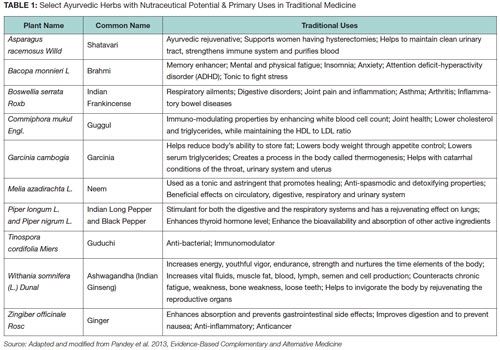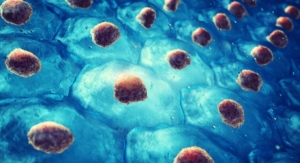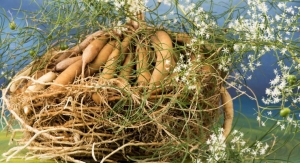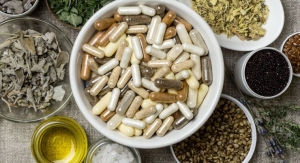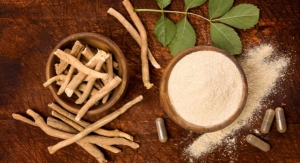Dilip Ghosh, PhD, FACN, nutriConnect07.01.14
India is known for its traditional medicinal systems—Ayurveda, Siddha and Unani, which are even mentioned in the ancient Vedas and other scriptures. The Ayurvedic concept appeared and developed between 2500 and 500 BC in India. The inner meaning of Ayurveda, “science of life,” comes from the ancient Indian system of healthcare focused on views of man and his illness. In Ayurveda, positive health means metabolically well balanced human beings, which offers a complete system to live a long healthy life (“science of longevity”) through diet and nutrition.
It was not long ago that Ayurvedic medicines and Ayurveda-derived dietary supplements were only found in a handful of health food stores in both India and abroad. These days, however, it is difficult to find a health food store that does not have Ayurveda-based herbal products on the shelf. Even in mainstream channels, food, drug and mass market grocery stores, and duty-free airport stores are starting to recognize the value of this class of herbs. Indeed, today a consumer does not have to go far to find products based on this ancient Indian system of medicine.
Paradigm Shift: From Cure To Prevention
In the 21st century, oriental medicinal herbs are gaining importance in mainstream healthcare as greater numbers of people seek relatively safe remedies and approaches to healthcare.
Demand for herbal medicines, herbal health products, herbal pharmaceuticals, nutraceuticals, food/dietary supplements and herbal cosmetics etc. is increasing globally due to the growing recognition of these products as mainly non-toxic, having lesser side effects, better compatibility with physiological flora and availability at affordable prices.
Earliest records suggest that herbal medicines have been used and documented in Indian, Chinese, Egyptian, Greek and Roman medicinal systems for about 5,000 years. Traditional herbal medicine has also been practiced from ancient times in American and Arabian countries and Japan. The transcripts of classical traditional medicine systems in India include Rigveda, Atherveda, Charaka Samhita and Sushruta Samhita. Folk (tribal) medicines are also important sources for the indigenous healthcare system. India has been known to be a rich repository of medicinal plants from ancient civilizations.
Ayurveda Defined
Ayurveda is a lifestyle science that was developed in India nearly 5,000 years ago. It is a holistic science based on a philosophy that good health comes from integrating all aspects of life such as herbs, food, exercise, yoga, massage and more. According to classical Ayurvedic theory, we are all born with a unique constitution referred to as Doshas, a mix of Vata, Pitta or Kapha. Each is present within our bodies and has a job to do: Vata is responsible for all motion, Pitta for all metabolic activities, and Kapha for maintaining the right amount of fluids in the body (i.e., water, blood, mucus, phlegm, etc.).
While all of us must have the three Doshas in our body to exist, we are born with a combination of these forces that is unique to each of us. This combination helps define our physical, mental and emotional make-up; it keeps our body in homeostasis and in turn the healthiest state we can be.
When the body goes out of this balanced state, eventually disease can occur. Hence, Vata imbalances are exhibited in health conditions that have to do with movement, such as joint conditions. Pitta imbalances lead to all types of metabolic and digestive diseases. Kapha imbalances most often involve excess of fluids, such as conditions of the lymphatic system.
Dietary Aspects of Ayurveda
In Ayurveda, the importance of diet in prevention and treatment of diseases was well known even in 1000 BC. For ages, because of their cultural beliefs and experiences people in India have taken herbs and herbal formulations as part of their daily food supplements. The faith in the power of botanicals along with the availability of a vast majority of different kinds of herbs in India has always been a thrust behind the survival of this scientific art of healing.
“Tat cha nityam prayunjeet svasthyam yen anuvartate. Ajaatanam vikaranam anuttpattikaram cha yat.” (Charaka Samhita: Sutra Sthana: 5)
(“The diet which besides providing the basic nutrition to the body, helps to maintain the healthy state of the body and prevents the occurrence of diseases should be consumed.”)
The science of food and nutritionals in Ayurveda was so developed that Charaka (an Ayurvedic scholar) has categorized all the food items into 12 classes: corns with bristles, pulses or legumes, meat, leafy vegetables, fruit, vegetables that are consumed raw, wines, water from different sources, milk and milk products, products of sugarcane, food preparations and accessory food items such as oils and salts, and has further subcategorized these food groups. Another classification is based on the consistency of food products: Peeta (liquid in consistency; advisable for newborns, children and diseased people and advocated in summer), Leeda (paste form that can be licked; advisable for children, convalescing and old people), Ashita (semi-solids; advised for aged people) and Khadita (solid food; advisable for young people with good digestion).
It is interesting to learn that Ayurveda lays a great emphasis on the quality of nutritious food for 1) averting the degenerative changes caused by aging (Rasayana), 2) convalescence after an illness (Balya), 3) enhancing the defense system (Roga Pratibandhaka Rasayana), 4) maintaining vigor and vitality (Vajikarana), and 5) for maintaining the joie-de-vivre (Jeevaniya).
The category of Rasayana drugs is divided into three categories, Kamya (for vitality, intellect, etc.), Naimitika (for specific disorders) and Aajasrika (general)—the last one dealing with the daily consumption of specific food products to rejuvenate the body. These food products are said to improve the quality of life by offering protection from internal and external stressors. The usage of nutraceuticals as advocated by Ayurveda can also be classified depending on the age of the individual, season of consumption, time of consumption, physiological conditions and according to the target organ.
Nutraceutical Potential of Ayurvedic Components
Dietary supplements including herbal remedies are popular complementary or alternative products. These preparations are intended to supplement the diet and contain one or more dietary ingredients (including vitamins, minerals, herbs or other botanicals, amino acids and other substances) or their constituents. These are intended to be taken orally as a pill, capsule, tablet or liquid and are labeled on the front panel as being a dietary/food supplement or nutraceutical.
Botanicals are sold in many forms, as fresh or dried products, liquid or solid extracts, tablets, capsules, powders, tea bags and so forth. For example, fresh ginger root is often used in various food stores; dried ginger root is sold packaged in tea bags, capsules or tablets, and liquid preparations made from ginger root are also sold in the market. A particular group of chemicals or a single chemical may be isolated from a botanical and sold as a dietary supplement, usually in tablet or capsule form. An example is phytoestrogens from soy products.
India is the largest producer of medicinal plants. There are currently about 250,000 registered medical practitioners of the Ayurvedic system, as compared to about 700,000 of modern medicine. In India, around 20,000 medicinal plants have been recorded; however, traditional practitioners use only 7,000–7,500 plants for curing different diseases. The proportion of use of plants in the different Indian systems of medicine is Ayurveda 2,000, Siddha 1,300, Unani 1,000, Homeopathy 800, Tibetan 500, Modern 200 and Folk 4,500.
In India, around 25,000 effective plant-based formulations are used in traditional and folk medicine. More than 1.5 million practitioners are using the traditional medicinal system for healthcare in India. It is estimated that more than 7,800 manufacturing units are involved in the production of natural health products and traditional plant-based formulations in India, which requires more than 2,000 tons of medicinal plant raw material annually. More than 1,500 herbals are sold as dietary supplements or ethnic traditional medicines.
Some common medicinal plants having nutraceutical potential and their primary use in traditional medicine are presented in Table 1.

New Era of Ayurveda
Recent research has shown that consumers are beginning to accept the premise that there is no “magic pill” and that good health comes from integrating all aspects of life. Herbal therapies, diet, exercise and vitamins all work better when used as part of a lifestyle plan. Ayurveda has embodied this principal for centuries. As Westerns seek ways to devise a healthy lifestyle plan, they will find Ayurveda offers all the tools they need to take care of their health on a daily basis. This may explain the resurgence in the acceptance of Ayurveda. As the awareness of Ayurveda increases in the West, so will consumer demand for Ayurvedic herbs. Some will follow classical Ayurvedic recipes and devise a lifestyle plan based on their Doshas (Vata, Pitta, Kapha). Many others are positioned as dietary/food supplements or nutraceuticals for mass market penetration.
Emerging Evidence-Based Products from Ayurveda
KeenMind (www.keenmind.info) is the result of more than 40 years of research. It demonstrates benefits for enhancing memory retention and recall, improving mental clarity and focus, as well as assisting learning, concentration and attention. KeenMind contains a special extract called CDRI 08, which is made from an Indian Ayurvedic herb, Bacopa monnieri. It is a natural nootropic (well tolerated cognitive enhancer) designed to improve and protect brain function. Numerous randomized, double-blind, placebo-controlled studies on KeenMind have provided an excellent platform to assess the utility of treatment in humans for maintenance and improvement of cognitive functions and normal cognitive aging.
CurcuWIN (www.omniactives.com), a new formulation of curcumin with a combination of hydrophilic carrier, cellulosic derivatives and natural antioxidants significantly increases curcuminoid appearance (46 times) in the blood in comparison to unformulated standard curcumin. There is potential industry confusion between turmeric and curcumin. Curcumin in CurcuWIN refers to three curcuminoids naturally found in turmeric. CurcuWIN utilizes the patented UltraSOL Dry Nutrient System Technology for enhancing solubility and bioavailability of lipophilic compounds with strong support from well-controlled human trials.
Casperome (www.indena.com) is a purified mixture of triterpenoid acids from the gum resin of Boswellia serrata, an Indian Ayurvedic herb. Casperome, highly standardized in boswellic acids, is furthermore formulated with Phytosome technology to achieve optimized absorption of the actives such as 11-keto-beta boswellic (KBA) and its acetylated counterpart (AKBA). The bioavailability of boswellic acids from Casperome is greatly optimized both at the plasma and at the tissue level by several randomized, controlled, human trials.
Conclusion
The association of nutraceuticals with traditional Ayurvedic medicine is bound to bring long lasting consumer acceptance. When supported by current modern medical research, the acceptance is whole hearted. The three examples mentioned previously are just a few of the many evidence-based, clinically proven nutraceutical products picked from a list of ground breaking natural products coming from the Indian Ayurvedic domain.
Numerous nutraceutical combinations have entered the international market through exploration of ethno-pharmacological claims made by different traditional practices without robust quality, safety and efficacy proves. More evidence is needed before these products can be broadly integrated into national health systems for disease prevention.
Dilip Ghosh, PhD, FACN, is director of nutriConnect, based in Sydney, Australia. He is also professionally involved with Soho Flordis International, the University of Western Sydney, Australia, and is an Honorary Ambassador with the Global Harmonization Initiative (GHI). Dr. Ghosh received his PhD in biomedical science from University of Calcutta, India. He has been involved in drug-development (both synthetic and natural) and functional food research and development both in academic and industry domains. Dr. Ghosh has published more than 60 papers in peer-reviewed journals, and he has authored two recent books, “Biotechnology in Functional Foods and Nutraceuticals,” and “Innovation in Healthy and Functional Foods,” under CRC Press. His next book, “Clinical Perspective of Functional Foods and Nutraceuticals” is in press. He can be reached at dilipghosh@nutriconnect.com.au; www.nutriconnect.com.au.
It was not long ago that Ayurvedic medicines and Ayurveda-derived dietary supplements were only found in a handful of health food stores in both India and abroad. These days, however, it is difficult to find a health food store that does not have Ayurveda-based herbal products on the shelf. Even in mainstream channels, food, drug and mass market grocery stores, and duty-free airport stores are starting to recognize the value of this class of herbs. Indeed, today a consumer does not have to go far to find products based on this ancient Indian system of medicine.
Paradigm Shift: From Cure To Prevention
In the 21st century, oriental medicinal herbs are gaining importance in mainstream healthcare as greater numbers of people seek relatively safe remedies and approaches to healthcare.
Demand for herbal medicines, herbal health products, herbal pharmaceuticals, nutraceuticals, food/dietary supplements and herbal cosmetics etc. is increasing globally due to the growing recognition of these products as mainly non-toxic, having lesser side effects, better compatibility with physiological flora and availability at affordable prices.
Earliest records suggest that herbal medicines have been used and documented in Indian, Chinese, Egyptian, Greek and Roman medicinal systems for about 5,000 years. Traditional herbal medicine has also been practiced from ancient times in American and Arabian countries and Japan. The transcripts of classical traditional medicine systems in India include Rigveda, Atherveda, Charaka Samhita and Sushruta Samhita. Folk (tribal) medicines are also important sources for the indigenous healthcare system. India has been known to be a rich repository of medicinal plants from ancient civilizations.
Ayurveda Defined
Ayurveda is a lifestyle science that was developed in India nearly 5,000 years ago. It is a holistic science based on a philosophy that good health comes from integrating all aspects of life such as herbs, food, exercise, yoga, massage and more. According to classical Ayurvedic theory, we are all born with a unique constitution referred to as Doshas, a mix of Vata, Pitta or Kapha. Each is present within our bodies and has a job to do: Vata is responsible for all motion, Pitta for all metabolic activities, and Kapha for maintaining the right amount of fluids in the body (i.e., water, blood, mucus, phlegm, etc.).
While all of us must have the three Doshas in our body to exist, we are born with a combination of these forces that is unique to each of us. This combination helps define our physical, mental and emotional make-up; it keeps our body in homeostasis and in turn the healthiest state we can be.
When the body goes out of this balanced state, eventually disease can occur. Hence, Vata imbalances are exhibited in health conditions that have to do with movement, such as joint conditions. Pitta imbalances lead to all types of metabolic and digestive diseases. Kapha imbalances most often involve excess of fluids, such as conditions of the lymphatic system.
Dietary Aspects of Ayurveda
In Ayurveda, the importance of diet in prevention and treatment of diseases was well known even in 1000 BC. For ages, because of their cultural beliefs and experiences people in India have taken herbs and herbal formulations as part of their daily food supplements. The faith in the power of botanicals along with the availability of a vast majority of different kinds of herbs in India has always been a thrust behind the survival of this scientific art of healing.
“Tat cha nityam prayunjeet svasthyam yen anuvartate. Ajaatanam vikaranam anuttpattikaram cha yat.” (Charaka Samhita: Sutra Sthana: 5)
(“The diet which besides providing the basic nutrition to the body, helps to maintain the healthy state of the body and prevents the occurrence of diseases should be consumed.”)
The science of food and nutritionals in Ayurveda was so developed that Charaka (an Ayurvedic scholar) has categorized all the food items into 12 classes: corns with bristles, pulses or legumes, meat, leafy vegetables, fruit, vegetables that are consumed raw, wines, water from different sources, milk and milk products, products of sugarcane, food preparations and accessory food items such as oils and salts, and has further subcategorized these food groups. Another classification is based on the consistency of food products: Peeta (liquid in consistency; advisable for newborns, children and diseased people and advocated in summer), Leeda (paste form that can be licked; advisable for children, convalescing and old people), Ashita (semi-solids; advised for aged people) and Khadita (solid food; advisable for young people with good digestion).
It is interesting to learn that Ayurveda lays a great emphasis on the quality of nutritious food for 1) averting the degenerative changes caused by aging (Rasayana), 2) convalescence after an illness (Balya), 3) enhancing the defense system (Roga Pratibandhaka Rasayana), 4) maintaining vigor and vitality (Vajikarana), and 5) for maintaining the joie-de-vivre (Jeevaniya).
The category of Rasayana drugs is divided into three categories, Kamya (for vitality, intellect, etc.), Naimitika (for specific disorders) and Aajasrika (general)—the last one dealing with the daily consumption of specific food products to rejuvenate the body. These food products are said to improve the quality of life by offering protection from internal and external stressors. The usage of nutraceuticals as advocated by Ayurveda can also be classified depending on the age of the individual, season of consumption, time of consumption, physiological conditions and according to the target organ.
Nutraceutical Potential of Ayurvedic Components
Dietary supplements including herbal remedies are popular complementary or alternative products. These preparations are intended to supplement the diet and contain one or more dietary ingredients (including vitamins, minerals, herbs or other botanicals, amino acids and other substances) or their constituents. These are intended to be taken orally as a pill, capsule, tablet or liquid and are labeled on the front panel as being a dietary/food supplement or nutraceutical.
Botanicals are sold in many forms, as fresh or dried products, liquid or solid extracts, tablets, capsules, powders, tea bags and so forth. For example, fresh ginger root is often used in various food stores; dried ginger root is sold packaged in tea bags, capsules or tablets, and liquid preparations made from ginger root are also sold in the market. A particular group of chemicals or a single chemical may be isolated from a botanical and sold as a dietary supplement, usually in tablet or capsule form. An example is phytoestrogens from soy products.
India is the largest producer of medicinal plants. There are currently about 250,000 registered medical practitioners of the Ayurvedic system, as compared to about 700,000 of modern medicine. In India, around 20,000 medicinal plants have been recorded; however, traditional practitioners use only 7,000–7,500 plants for curing different diseases. The proportion of use of plants in the different Indian systems of medicine is Ayurveda 2,000, Siddha 1,300, Unani 1,000, Homeopathy 800, Tibetan 500, Modern 200 and Folk 4,500.
In India, around 25,000 effective plant-based formulations are used in traditional and folk medicine. More than 1.5 million practitioners are using the traditional medicinal system for healthcare in India. It is estimated that more than 7,800 manufacturing units are involved in the production of natural health products and traditional plant-based formulations in India, which requires more than 2,000 tons of medicinal plant raw material annually. More than 1,500 herbals are sold as dietary supplements or ethnic traditional medicines.
Some common medicinal plants having nutraceutical potential and their primary use in traditional medicine are presented in Table 1.
New Era of Ayurveda
Recent research has shown that consumers are beginning to accept the premise that there is no “magic pill” and that good health comes from integrating all aspects of life. Herbal therapies, diet, exercise and vitamins all work better when used as part of a lifestyle plan. Ayurveda has embodied this principal for centuries. As Westerns seek ways to devise a healthy lifestyle plan, they will find Ayurveda offers all the tools they need to take care of their health on a daily basis. This may explain the resurgence in the acceptance of Ayurveda. As the awareness of Ayurveda increases in the West, so will consumer demand for Ayurvedic herbs. Some will follow classical Ayurvedic recipes and devise a lifestyle plan based on their Doshas (Vata, Pitta, Kapha). Many others are positioned as dietary/food supplements or nutraceuticals for mass market penetration.
Emerging Evidence-Based Products from Ayurveda
KeenMind (www.keenmind.info) is the result of more than 40 years of research. It demonstrates benefits for enhancing memory retention and recall, improving mental clarity and focus, as well as assisting learning, concentration and attention. KeenMind contains a special extract called CDRI 08, which is made from an Indian Ayurvedic herb, Bacopa monnieri. It is a natural nootropic (well tolerated cognitive enhancer) designed to improve and protect brain function. Numerous randomized, double-blind, placebo-controlled studies on KeenMind have provided an excellent platform to assess the utility of treatment in humans for maintenance and improvement of cognitive functions and normal cognitive aging.
CurcuWIN (www.omniactives.com), a new formulation of curcumin with a combination of hydrophilic carrier, cellulosic derivatives and natural antioxidants significantly increases curcuminoid appearance (46 times) in the blood in comparison to unformulated standard curcumin. There is potential industry confusion between turmeric and curcumin. Curcumin in CurcuWIN refers to three curcuminoids naturally found in turmeric. CurcuWIN utilizes the patented UltraSOL Dry Nutrient System Technology for enhancing solubility and bioavailability of lipophilic compounds with strong support from well-controlled human trials.
Casperome (www.indena.com) is a purified mixture of triterpenoid acids from the gum resin of Boswellia serrata, an Indian Ayurvedic herb. Casperome, highly standardized in boswellic acids, is furthermore formulated with Phytosome technology to achieve optimized absorption of the actives such as 11-keto-beta boswellic (KBA) and its acetylated counterpart (AKBA). The bioavailability of boswellic acids from Casperome is greatly optimized both at the plasma and at the tissue level by several randomized, controlled, human trials.
Conclusion
The association of nutraceuticals with traditional Ayurvedic medicine is bound to bring long lasting consumer acceptance. When supported by current modern medical research, the acceptance is whole hearted. The three examples mentioned previously are just a few of the many evidence-based, clinically proven nutraceutical products picked from a list of ground breaking natural products coming from the Indian Ayurvedic domain.
Numerous nutraceutical combinations have entered the international market through exploration of ethno-pharmacological claims made by different traditional practices without robust quality, safety and efficacy proves. More evidence is needed before these products can be broadly integrated into national health systems for disease prevention.
Dilip Ghosh, PhD, FACN, is director of nutriConnect, based in Sydney, Australia. He is also professionally involved with Soho Flordis International, the University of Western Sydney, Australia, and is an Honorary Ambassador with the Global Harmonization Initiative (GHI). Dr. Ghosh received his PhD in biomedical science from University of Calcutta, India. He has been involved in drug-development (both synthetic and natural) and functional food research and development both in academic and industry domains. Dr. Ghosh has published more than 60 papers in peer-reviewed journals, and he has authored two recent books, “Biotechnology in Functional Foods and Nutraceuticals,” and “Innovation in Healthy and Functional Foods,” under CRC Press. His next book, “Clinical Perspective of Functional Foods and Nutraceuticals” is in press. He can be reached at dilipghosh@nutriconnect.com.au; www.nutriconnect.com.au.


